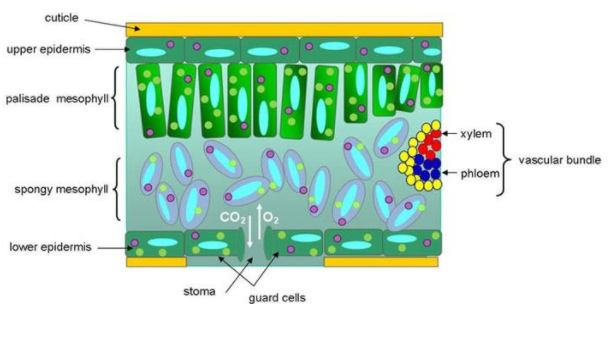
Describe the internal structure of a dorsiventral leaf with the help of labelled diagram.
Answer
465.9k+ views
Hint:Dicot plants are those plants in which two cotyledons are found. In dicot plants, dorsive central leaves are found. These leaves possess distinct ventral and dorsal sides.
Complete answer:
The dorsive central leaf comprises three parts.
Epidermis: Epidermis is present on both the upper surface (adaxial epidermis) and the lower surface (abaxial epidermis). The epidermis on the outside is covered with a thick cuticle. The abaxial epidermis bears more stomata than the adaxial epidermis. The outermost covering of the leaf on the upper side is called adaxial epidermis and on the lower side, it is known as the abaxial epidermis. A waxy thick layer cuticle is present and distinct. Stomata are higher on the abaxial epidermis and either lower or absent on the adaxial epidermis.

Mesophyll: Mesophyll is a tissue of the leaf present between the adaxial and abaxial epidermis. It is differentiated into the palisade parenchyma (composed of tall, compactly-placed cells) and the spongy parenchyma (comprising oval or round, loosely-arranged cells with intercellular spaces). Mesophyll contains the chloroplasts which perform the function of photosynthesis.
Vascular system: The vascular bundles present in leaves are conjoint and closed. They are surrounded by thick layers of bundle-sheath cells or these are surrounded by thick bundle sheath cells and can be seen in veins and midrib. These are distinct in size due to reticulate venation.
Note:It is to be noted that the male components of the flower are referred to as the stamens while the female flower part is called pistil.
Complete answer:
The dorsive central leaf comprises three parts.
Epidermis: Epidermis is present on both the upper surface (adaxial epidermis) and the lower surface (abaxial epidermis). The epidermis on the outside is covered with a thick cuticle. The abaxial epidermis bears more stomata than the adaxial epidermis. The outermost covering of the leaf on the upper side is called adaxial epidermis and on the lower side, it is known as the abaxial epidermis. A waxy thick layer cuticle is present and distinct. Stomata are higher on the abaxial epidermis and either lower or absent on the adaxial epidermis.

Mesophyll: Mesophyll is a tissue of the leaf present between the adaxial and abaxial epidermis. It is differentiated into the palisade parenchyma (composed of tall, compactly-placed cells) and the spongy parenchyma (comprising oval or round, loosely-arranged cells with intercellular spaces). Mesophyll contains the chloroplasts which perform the function of photosynthesis.
Vascular system: The vascular bundles present in leaves are conjoint and closed. They are surrounded by thick layers of bundle-sheath cells or these are surrounded by thick bundle sheath cells and can be seen in veins and midrib. These are distinct in size due to reticulate venation.
Note:It is to be noted that the male components of the flower are referred to as the stamens while the female flower part is called pistil.
Recently Updated Pages
Can anyone list 10 advantages and disadvantages of friction

What are the Components of Financial System?

How do you arrange NH4 + BF3 H2O C2H2 in increasing class 11 chemistry CBSE

Is H mCT and q mCT the same thing If so which is more class 11 chemistry CBSE

What are the possible quantum number for the last outermost class 11 chemistry CBSE

Is C2 paramagnetic or diamagnetic class 11 chemistry CBSE

Trending doubts
Which is not a source of freshwater 1 Glaciers and class 11 chemistry CBSE

10 examples of friction in our daily life

The correct order of melting point of 14th group elements class 11 chemistry CBSE

Difference Between Prokaryotic Cells and Eukaryotic Cells

One Metric ton is equal to kg A 10000 B 1000 C 100 class 11 physics CBSE

What is the specific heat capacity of ice water and class 11 physics CBSE




